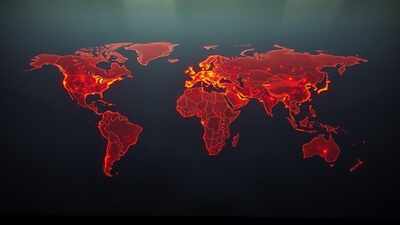NEW DELHI: Year 2025 is set to be either the second or third warmest year on record as an alarming streak of exceptional temperatures continues, driven by record heat-trapping greenhouse gas (GHG) concentrations in the atmosphere, the World Meteorological Organisation (WMO) said on Thursday.So far, 2024 was the warmest year on record followed by 2023, the previous warmest. Both these years alongwith 2025 may, therefore, now be the three warmest years on record.Releasing its latest update on the state of global climate ahead of the annual UN climate summit (COP30) in Belem, Brazil, the global met body noted that the global mean near-surface temperature from Jan to Aug 2025 was 1.42 degree Celsius (± 0.12 degree C) above the pre-industrial (1850-1900) average, which was lower compared to 1.55 degree C (± 0.13 degree C) for the year 2024. The average temperature rise was 1.45 degree C in 2023. The update, based on six international datasets, showed that the 26-month period from June 2023 to Aug 2025 saw an extended streak of monthly record-breaking temperatures (apart from Feb 2025), and 2015 to 2025 will be the warmest 11 years on record in the 176-year observational history.Flagging record-high observed concentrations of the three key GHG in the atmosphere – carbon dioxide, methane and nitrous oxide – in 2024, the WMO said that the measurements to date from individual locations suggest that the levels of such concentrations will be even higher in 2025. “This unprecedented streak of high temperatures, combined with last year’s record increase in GHG levels, makes it clear that it will be virtually impossible to limit global warming to 1.5 degree C in the next few years without temporarily overshooting this target,” said WMO secretary-general Celeste Saulo.She, however, said the science is equally clear that it’s still entirely possible and essential to bring temperatures back down to 1.5 degree C by the end of the century — the Paris Agreement’s goal of making efforts to limit global warming within that level.Though the year 2024 breached the Paris Agreement threshold of 1.5 degree c above pre-industrial (1850-1900) levels for the first time, one or more individual years exceeding 1.5 degree C does not necessarily mean that pursuing efforts to limit the temperature increase to 1.5 degree C is out of reach. Exceedance of warming levels, as referred to in the Paris deal, can be measured over an extended period, typically decades or longer.Referring to the average temperature rise in 2025, the WMO also flagged that the Arctic sea ice extent after the winter freeze was the lowest on record, Antarctic sea ice extent tracked well below average throughout the year, and long-term sea level rise trend continued.“Each year above 1.5 degree C will hammer economies, deepen inequalities and inflict irreversible damage. We must act now, at great speed and scale, to make the overshoot as small, as short, and as safe as possible – and bring temperatures back below 1.5 degree C before the end of the century,” said UN secretary-general António Guterres.



